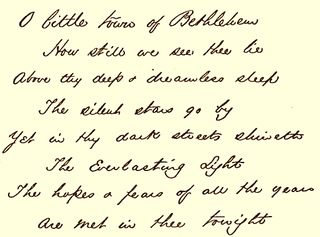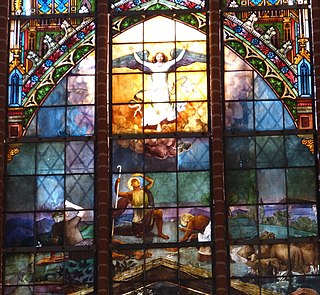
John Milford Rutter is an English composer, conductor, editor, arranger, and record producer, mainly of choral music.
"The Cherry-Tree Carol" is a ballad with the rare distinction of being both a Christmas carol and one of the Child Ballads. The song itself is very old, reportedly sung in some form at the Feast of Corpus Christi in the early 15th century.
The "Huron Carol" is a Canadian Christmas hymn, written probably in 1642 by Jean de Brébeuf, a Jesuit missionary at Sainte-Marie among the Hurons in Canada. Brébeuf wrote the lyrics in the native language of the Huron/Wendat people; the song's original Huron title is "Jesous Ahatonhia". The song's melody is based on a traditional French folk song, "Une Jeune Pucelle". The well-known English lyrics were written in 1926 by Jesse Edgar Middleton and the copyright to these lyrics was held by The Frederick Harris Music Co., Limited, but entered the public domain in 2011.

Patrick Hawes is a British composer, conductor, organist and pianist.

Gaudete is a sacred Christmas carol, thought to have been composed in the 16th century. It was published in Piae Cantiones, a collection of Finnish/Swedish sacred songs published in 1582. No music is given for the verses, but the standard tune comes from older liturgical books.
"I Saw Three Ships (Come Sailing In)" is an English Christmas carol, listed as number 700 in the Roud Folk Song Index. The earliest printed version of "I Saw Three Ships" is from the 17th century, possibly Derbyshire, and was also published by William Sandys in 1833. The song was probably traditionally known as "As I Sat On a Sunny Bank", and was particularly popular in Cornwall.

"I Wonder as I Wander" is a Christian folk hymn, typically performed as a Christmas carol, written by American folklorist and singer John Jacob Niles. The hymn has its origins in a song fragment collected by Niles on July 16, 1933.

"In the Bleak Midwinter" is a poem by the English poet Christina Rossetti, commonly performed as a Christmas carol. The poem was published, under the title "A Christmas Carol", in the January 1872 issue of Scribner's Monthly, and was first collected in book form in Goblin Market, The Prince's Progress and Other Poems.

"O Little Town of Bethlehem" is a Christmas carol. Based on an 1868 text written by Phillips Brooks, the carol is popular on both sides of the Atlantic, but to different tunes: in the United States, to "St. Louis" by Brooks' collaborator, Lewis Redner; and in the United Kingdom, Canada, and Ireland to "Forest Green", a tune collected by Ralph Vaughan Williams and first published in the 1906 English Hymnal.
The Corpus Christi Carol or Falcon Carol is a Middle or Early Modern English hymn, first written down by an apprentice grocer named Richard Hill between 1504 and 1536. The original writer of the carol remains anonymous. The earliest surviving record of the piece preserves only the lyrics and is untitled. It has survived in altered form in the folk tradition as the Christmas carol "Down In Yon Forest". The structure of the carol is six stanzas, each with rhyming couplets. The tense changes in the fourth stanza from past to present continuous.
"Tu scendi dalle stelle" is a Christmas carol from Italy, written in 1744 in Bovino by Saint Alphonses Liguori in the musical style of a pastorale. Though found in numerous arrangements and commonly sung, it is traditionally associated with the zampogna, or large-format Italian bagpipe.

Hodie is a cantata by Ralph Vaughan Williams. Composed between 1953 and 1954, it is the composer's last major choral-orchestral composition, and was premiered under his baton at Worcester Cathedral, as part of the Three Choirs Festival, on 8 September 1954. The piece is dedicated to Herbert Howells. The cantata, in 16 movements, is scored for chorus, boys' choir, organ and orchestra, and features tenor, baritone, and soprano soloists.
"Angelus ad virginem" is a medieval carol whose text is a poetic version of the Hail Mary and the Annunciation by the archangel Gabriel to the Virgin Mary.
The Wexford Carol or the Enniscorthy Carol is a traditional religious Irish Christmas carol originating from Enniscorthy in County Wexford. The subject of the song is the nativity of Jesus Christ.

"Rorate caeli" or "Rorate coeli" are the opening words of Isaiah 45:8 in the Vulgate. The text appears at several points in the Christian liturgy of the Western Church during Advent.

The annunciation to the shepherds is an episode in the Nativity of Jesus described in the Bible in Luke 2, in which angels tell a group of shepherds about the birth of Jesus. It is a common subject of Christian art and of Christmas carols.

The Animals' Christmas is the sixth solo studio album and the first Christmas album by vocalist Art Garfunkel, and is a collaborative album with Amy Grant, released in October 1986 by Columbia Records. The album was written by Jimmy Webb and features vocals by Garfunkel, Grant, and Wimbledon King's College Choir. The Animals' Christmas tells the story of the Nativity of Jesus from the perspective of the animals present. The album received positive reviews, with one writer calling it "one of the best Christmas albums of the '80s." The album failed to chart.

Edgar Pettman (1866–1943) was an English organist, choral conductor and music editor. Born in Dunkirk, Kent, in 1881 he entered the Royal Academy of Music where he studied under George Alexander Macfarren. He was organist at a number of London churches, including St Mary's, Kilburn and St James's Church, Piccadilly until his retirement in 1924. Although the composer of a number of anthems and other church music, he is best known for his 1892 book Modern Christmas Carols. Pettman harmonized the now popular carols I Saw a Maiden and Gabriel's Message, both based on Basque carol melodies, publishing the latter in a pamphlet, The University Carol book, in 1922 with an English rendering by Sabine Baring-Gould. He was also an early editor of the works of Thomas Tallis, publishing an edition in 1900.

Angels' Carol is a popular sacred choral piece by John Rutter for Christmas. He wrote his own text, beginning "Have you heard the sound of the angel voices", three stanzas with the refrain "Gloria in excelsis Deo". It has been part of recordings of collections of Christmas music, including one conducted by the composer.

"Vom Himmel hoch, da komm ich her" is a hymn text relating to the Nativity of Jesus, written by Martin Luther in 1534. The hymn is most often sung to the melody, Zahn No. 346, which first appeared in a 1539 songbook and was probably also composed by Luther. This classic Christmas carol remains popular and has inspired many choral and organ works by other composers.














